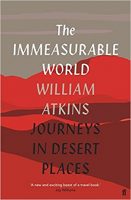The Immeasurable World: Journeys in Desert Places
By William Atkins
Faber & Faber (£20)
 While I was reading The Immeasurable World: Journeys in Desert Places, Donald Trump had yet to reverse his shameful policy of separating undocumented migrant children from their parents at America’s border. A picture was circulating on social media of two children lying in a cage in Nogales, Arizona, after being detained by the United States Border Patrol. The picture was presented as an example of the singular cruelty of the Trump administration — but it had been taken in 2014, during the presidency of Barack Obama.
While I was reading The Immeasurable World: Journeys in Desert Places, Donald Trump had yet to reverse his shameful policy of separating undocumented migrant children from their parents at America’s border. A picture was circulating on social media of two children lying in a cage in Nogales, Arizona, after being detained by the United States Border Patrol. The picture was presented as an example of the singular cruelty of the Trump administration — but it had been taken in 2014, during the presidency of Barack Obama.
Obama’s administration, and others before it, also detained immigrant families — parents and children together. Since the 1990s, as William Atkins points out, the doctrine of the US Border Patrol has been what it calls “prevention through deterrence”, the aim of which, according to a congressional report, “is to make it so difficult and so costly to enter this country illegally that fewer individuals even try”.
Still they come, though, the desperate people of El Salvador, Honduras, Guatemala and Mexico, fleeing systemic violence at home; and as they now have to attempt a crossing in the most isolated areas between Mexico and the US, more of them are perishing. Atkins, who spent time both with a group helping migrants and with a border patrol officer, reports that between October 2000 and September 2014 the number of bodies found in southern Arizona alone was 2,721. The desert — even without Trump’s wall — is a barrier, and often a deadly one.
It has also, at various times and in various cultures, been seen as a realm of demonic temptation and a monkish retreat, a proving ground for explorers and pioneers, a prison for criminals and dissidents, a “wasteland” for the testing of nuclear weapons, and an ideal venue for what Atkins calls “the most excessive party on earth”: the annual Burning Man festival, where last year 70,000 people made a spectacle of themselves on a dry lakebed in Nevada. The desert, as this subtle and quietly powerful book demonstrates, can be whatever the mind makes of it.
The Immeasurable World is a follow-up to The Moor, in which Atkins explored England’s most forbidding landscape and its place in history, culture and the national psyche. The dry is more hazardous than the damp: he has a couple of encounters with venomous snakes, though he comes closest to death inside a wilderness cabin in Arizona, when he fails to turn off his stove properly and nearly gases himself.
Not that he is intent on proving, like some sponsored 21st-century shadow of a genuine explorer, that he is a hard nut. To grind away at yourself like that, he says, is “to aspire to the condition of sand”. He had been reading about the connection between Christian monasticism and the desert; when he and his partner split up, he wondered whether, as the poet Marianne Moore has it, “the cure for loneliness is solitude”. In search of an answer, he dipped in and out of the desert on trips in the Middle East, Asia, Australia and the United States.
He journeys as much in the library as on the ground, deep into desert literature and lore, metaphor and myth, and the ways of hermit priests and watchful camels (“If your camel looks slowly left to right,” he is told, “it is [looking at] a fox. If your camel stops chewing and stares into the darkness, something is wrong.”).
And if the desert starts to grow? Well, that will be down to the intervention of human beings. When it was mapped on an expedition in 1848, the Aral Sea was the world’s fourth-largest lake, covering 26,000 square miles. Then, after the Russian Revolution, it was decided that the country should be self-sufficient in cotton. Water would be drawn from the Aral’s feeder rivers to make that possible. The result: the sea has been reduced to an area of less than 6,500 square miles. An old fisherman Atkins met (“born to the sound of lapping waves”)told him he had seen the water withdraw year by year, until the shore was two days’ walk away, and the water touching it all but dead.
It was a dissident Ukrainian poet and artist, Taras Shevchenko (a man banished to the desert by Tsar Nicholas I), who ended up documenting the 1848 expedition. His delicate sketches and watercolours, says Atkins, show “a tender, doctorly attention to sparsity… intimate regard for bleakness”. The same is true of The Immeasurable World. MK
This review appeared in The Daily Telegraph on July 28, 2018
